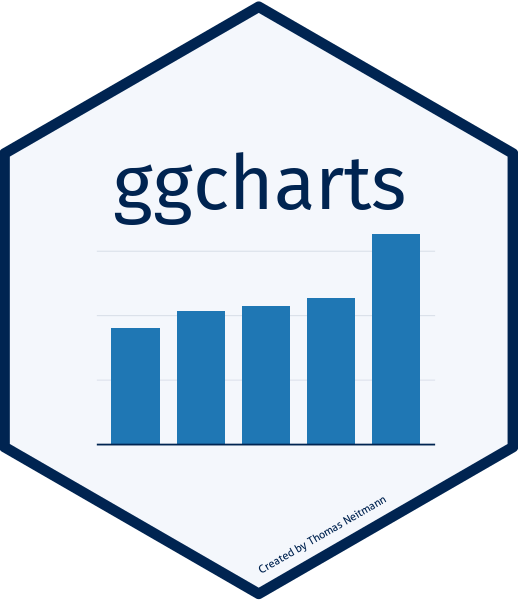Overview
{ggcharts} provides a high-level {ggplot2} interface for creating common charts. Its aim is both simple and ambitious: to get you from your data visualization idea to an actual plot faster. How so? By taking care of a lot of data preprocessing, obscure {ggplot2} details and plot styling for you. The resulting plots are ggplot objects and can be further customized using any {ggplot2} function.
Installation
The package is available from CRAN.
install.packages("ggcharts")
Alternatively, you can install the latest development version from GitHub.
if (!"remotes" %in% installed.packages()) { install.packages("remotes") } remotes::install_github("thomas-neitmann/ggcharts", upgrade = "never")
If you get an error when trying to install from GitHub, run this code and then try to install once again.
Sys.setenv(R_REMOTES_NO_ERRORS_FROM_WARNINGS = "true")
If the installation still fails please open an issue.
Why ggcharts?
Thanks to {ggplot2} you can create beautiful plots in R. However, it can often take quite a bit of effort to get from a data visualization idea to an actual plot. As an example, let’s say you want to create a faceted bar chart displaying the top 10 within each facet ordered from highest to lowest. What sounds simple is actually pretty hard to achieve. Have a look:
library(dplyr) library(ggplot2) library(ggcharts) data("biomedicalrevenue") biomedicalrevenue %>% filter(year %in% c(2012, 2015, 2018)) %>% group_by(year) %>% top_n(10, revenue) %>% ungroup() %>% mutate(company = tidytext::reorder_within(company, revenue, year)) %>% ggplot(aes(company, revenue)) + geom_col() + coord_flip() + tidytext::scale_x_reordered() + facet_wrap(vars(year), scales = "free_y")
That’s a lot of code! And you likely never heard of some of the functions involved. With {ggcharts} you can create the same plot (actually an even better looking one) in almost a single line of code.
biomedicalrevenue %>% filter(year %in% c(2012, 2015, 2018)) %>% bar_chart(x = company, y = revenue, facet = year, top_n = 10)
Gallery
Charts
data("revenue_wide") line_chart(data = revenue_wide, x = year, y = Roche:Bayer) + labs(x = "Year", y = "Revenue (Billion USD)")
biomedicalrevenue %>% filter(year == 2018) %>% lollipop_chart(x = company, y = revenue, threshold = 30) + labs( x = NULL, y = "Revenue", title = "Biomedical Companies with Revenue > $30Bn." ) + scale_y_continuous( labels = function(x) paste0("$", x, "Bn."), expand = expansion(mult = c(0, .05)) )
data("popeurope") dumbbell_chart( data = popeurope, x = country, y1 = pop1952, y2 = pop2007, top_n = 10, point_colors = c("lightgray", "#494F5C") ) + labs( x = NULL, y = "Population", title = "Europe's Largest Countries by Population in 2007" ) + scale_y_continuous( limits = c(0, NA), labels = function(x) paste(x, "Mn.") )
data(mtcars) mtcars_z <- dplyr::transmute( .data = mtcars, model = row.names(mtcars), hpz = scale(hp) ) diverging_bar_chart(data = mtcars_z, x = model, y = hpz)
diverging_lollipop_chart( data = mtcars_z, x = model, y = hpz, lollipop_colors = c("#006400", "#b32134"), text_color = c("#006400", "#b32134") )
data("popch") pyramid_chart(data = popch, x = age, y = pop, group = sex)
Themes
ggcharts_set_theme("theme_hermit") bar_chart(data = diamonds, x = cut)
ggcharts_set_theme("theme_ng") bar_chart(data = diamonds, x = cut)
ggcharts_set_theme("theme_nightblue") bar_chart(data = diamonds, x = cut)

